Get glowing skin while you sleep with this DIY green tea overnight face mask! Inspired by Korean skincare, this simple recipe helps brighten your skin overnight. It’s packed with antioxidants from green tea that help to repair skin while also soothing any redness or irritation.
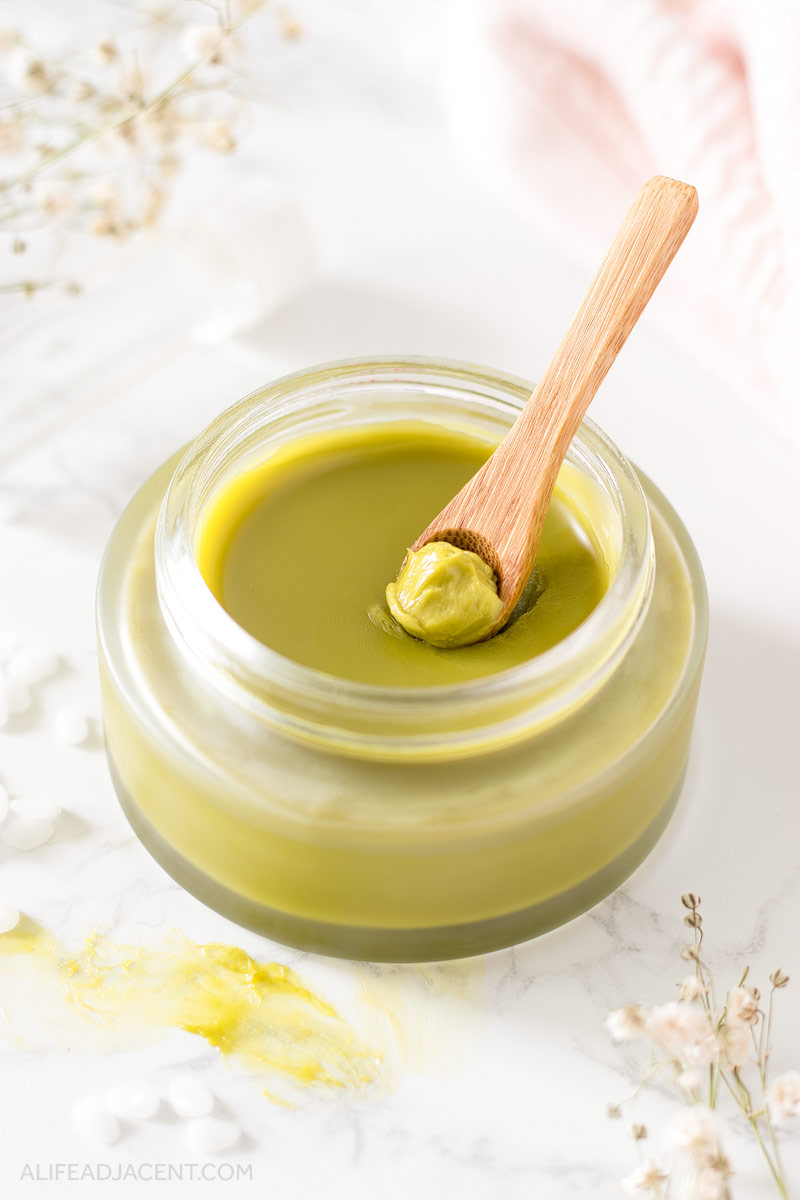
Last Updated June 4, 2021
Last year I shared one of my favourite homemade skincare products on the blog – my moisturizing overnight face mask. It’s still one of my favourites, and it’s earned a permanent spot in the collection of DIY skincare products I always keep on hand.
That mask is also of one my most viewed recipes, so if you tried it, I hope you liked it, too!
But since sharing that post, a bout of skin issues (likely caused by reintroducing retinol into my skincare routine) led me to create a new variation of that recipe.
In an effort to heal the onset of redness and hypersensitivity I experienced, I pared back my skincare products and incorporated soothing, anti-inflammatory green tea into my overnight mask.
That addition turned out to be very beneficial for my skin, so I’d like to share the new recipe with you, too.
If you love antioxidant skincare and the smell of green tea, you’ll definitely enjoy this DIY green tea overnight face mask.
A DIY overnight mask for glowing skin
By now you’ve likely heard of overnight masks. Otherwise known as sleeping masks or face packs, these rich night treatments have their roots in Korean beauty products.
Whichever name you use, the goal is the same – to keep skin hydrated throughout the night.
Some overnight masks offer other benefits as well, such as antioxidants or active ingredients like vitamin A. But the main purpose of overnight masks is to create a seal that locks in moisture along with your other skincare products.
This new green tea mask is for far more than just hydration. It has all the moisturizing properties of an overnight mask, but with added antioxidant and reparative benefits that will help you get glowing skin.
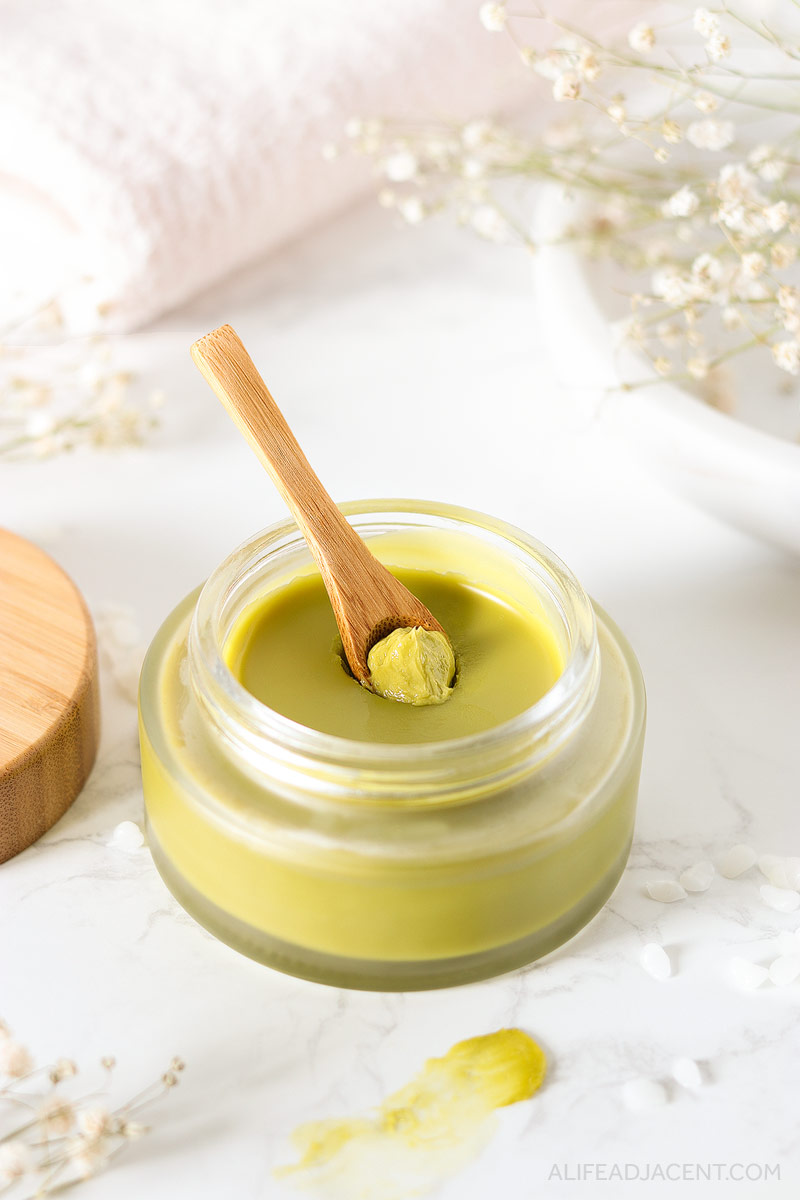
Why I created this green tea overnight mask
Whether it’s caused by fluctuations in temperature, hormone imbalance, or stress levels, sometimes our skin needs a change in routine.
Over this past year, I experienced some changes in my skin that led me to switch up my own skincare routine.
I’ve always had dry, sensitive, irritation-prone skin. I can’t use most store- bought skincare products, and I’ve memorized a long list of ingredients that will provoke a reaction.
But around a year ago, these qualities became more pronounced. Patches of redness cropped up on my cheeks, and even some of my go-to skincare products started stinging my skin.
I’m not exactly sure what to attribute these changes to, but it’s likely that using retinol too frequently played a role.
After doing some research, I decided to incorporate green tea into my nightly sleeping mask for its anti-inflammatory benefits.
I also scaled back my skincare routine to the bare minimum – a mineral sunscreen, gentle K-beauty moisturizers, my DIY cleansing oil, and my green tea overnight mask.
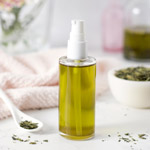
DIY Green Tea Oil Cleanser
Thankfully, I’m happy to say that my skin healed after months of this simplified routine, to the point where it can even tolerate retinol again.
I’m not an expert, but I think it’s likely that the combination of gentle skincare products helped my skin repair itself. As well, I suspect the soothing, antioxidant properties of green tea could have also played a role.
As it turns out, there’s a lot of evidence to back up green tea’s effectiveness for certain skin issues.
Why you should add green tea to your overnight mask
Green tea possesses many well-documented skin benefits. It’s been shown to improve skin moisture levels and enhance wound healing, which makes it beneficial for dry, irritated skin.
As well, green tea has soothing, anti-inflammatory properties that make it effective against a variety of skin disorders, including rosacea, eczema, and acne.

These skin benefits can be attributed to green tea’s high levels of catechins, a group of flavonoids that act as potent antioxidants.
But green tea’s effects are not limited to these conditions only. Acute issues like sunburn, redness, and irritation are also included, and there’s evidence that green tea can be beneficial for pigmentation issues as well.
In fact, since most skin disorders have an inflammatory component, it’s difficult to find a skin ailment that green tea cannot help improve in some way.
Benefits of green tea for skincare
During a study on people with rosacea, green tea demonstrated significant anti-inflammatory effects. And in acne sufferers, a green tea skin lotion was shown to reduce inflammation and acne severity.
In yet another study, those with atopic dermatitis and pruritus (itching) found relief by bathing in green tea extracts.
Finally, green tea has also been found to help protect against UV rays and the associated skin damage and photoaging. This makes it a useful ingredient to include in your summer skincare routine.
I could go on about green tea’s skin benefits, but you likely get the picture. The main takeaway is that green tea can be useful for any skin disorder where dryness, redness or inflammation is a factor.
This does not mean to suggest that green tea is a miracle cure – it won’t get you flawless skin overnight, but it’s a great adjunct to a good skincare routine.
Over time, adding green tea to your overnight mask might just help you wake up with a softer, more glowing complexion.
Green tea overnight mask ingredients
Green tea wax
As we’ve discussed, the star ingredient of this mask is of course green tea.
Enter green tea wax. This unique substance is harvested from the waxy layer found on green tea leaves, and it’s chock full of skin benefits.
If you love the aroma of a steaming cup of green tea, you will definitely love green tea wax. Highly pigmented and strongly fragranced, a small chunk of wax imparts a rich green tea colour and scent to this overnight mask.
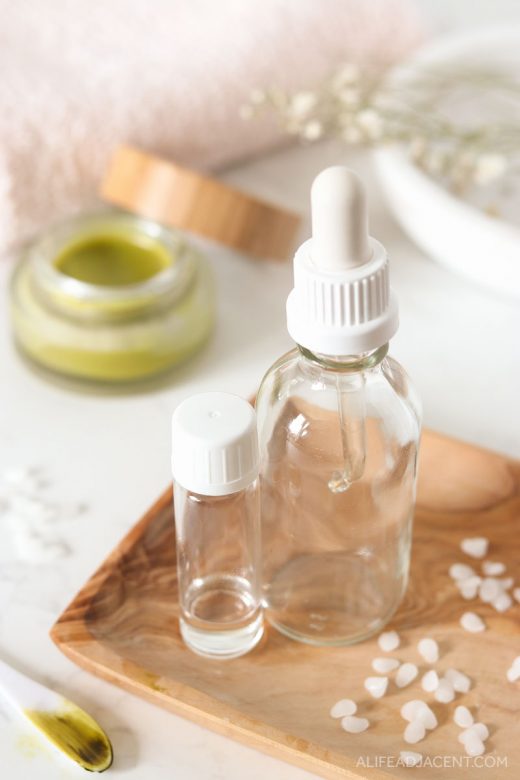
It’s hard to find information about this unique ingredient, and that’s likely because it hides under a different name.
Green tea wax’s INCI name is Camellia sinensis leaf extract. This can obviously cause some confusion with green tea extract.
But according to SkinChakra, green tea wax is both a wax and an extract – a CO2 extract, to be exact. The wax is extracted with carbon dioxide, which preserves the antioxidants, terpenes, polyphenols, and other beneficial constituents in the green tea leaves.
Green tea wax is like an oil soluble green tea extract, making it the perfect ingredient to include in an oil-based balm like this overnight mask. I also love using green tea wax in my green tea oil cleanser.
Of course, green tea’s benefits aren’t just limited to the face. If you have dry hands, you may want to try using it in a hand treatment as well. You can also find green tea wax in my overnight hand mask.
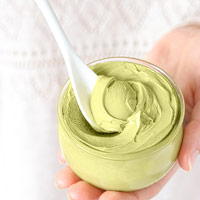
Related
DIY Hand Mask for Dry Skin
Matcha powder
After publishing this post, I received questions about substitutions for those who can’t find green tea wax. So I wanted to offer another option to make this DIY accessible to everyone.
Fortunately, there are two simple substitutes. You’re likely familiar with the first substitute, as it’s very easy to find: matcha powder!
At first I was concerned that matcha would give the mask a grainy texture, but after testing it myself, I was pleasantly surprised at the results.
Since matcha is not oil soluble, it will leave some sediment at the bottom of your mask. However, the rest of the product will be just as smooth and silky as the version using green tea wax.
The key to using matcha powder is to let it infuse into your face mask, which I will cover in the recipe card below.
There are a variety of different grades of matcha, but you can use any kind of matcha powder you have access to. I recommend opting for organic matcha if it’s available.
However, the most important thing is to make sure your matcha is pure and free of any additives like corn starch or sugar. So while matcha latte mixes are delicious, please don’t use them for this recipe.
Green tea infused oil
The second substitute for green tea wax is green tea infused oil. Brightly coloured, fragrant, and full of skin benefits, green tea oil is very easy to make.
As long as you have green tea, you can make green tea oil. Simply infuse loose green tea leaves into your squalane oil, and used the infused oil to make your sleeping mask.
For more information on making your own green tea infused oil, see my new post on green tea cleansing oil, where I go into more detail on the process.
Squalane oil
Squalane oil makes the perfect non-greasy base for this green tea sleeping mask.
This unique oil has gained a lot of popularity in recent years, so you’ve likely heard about it. But if you’ve never encountered squalane before, it’s truly unlike any other facial oil.
In fact, though it looks and behaves like one, squalane is not technically an oil at all. It’s a hydrocarbon created by hydrogenating squalene, a natural compound secreted by our sebaceous glands.
However, the difference is that our skin’s natural squalene is comedogenic and easily oxidized, where squalane is neither.
Squalane is chemically inert, highly stable, and won’t clog pores or cause irritation. It has a light, dry texture and an almost silicone-like feel that disappears into skin.
As a result, it doesn’t feel oily or heavy. It’s also well-tolerated by most skin types, even the oily and acne-prone.
As well, squalane doesn’t feed malassezia yeast, making it one of the only oils safe for those with seborrheic dermatitis, fungal acne, or other disorders caused by yeast overgrowth.
Finally, squalane oil is completely devoid of polyunsaturated fatty acids, which makes it ideal for those following a low-PUFA skincare routine.
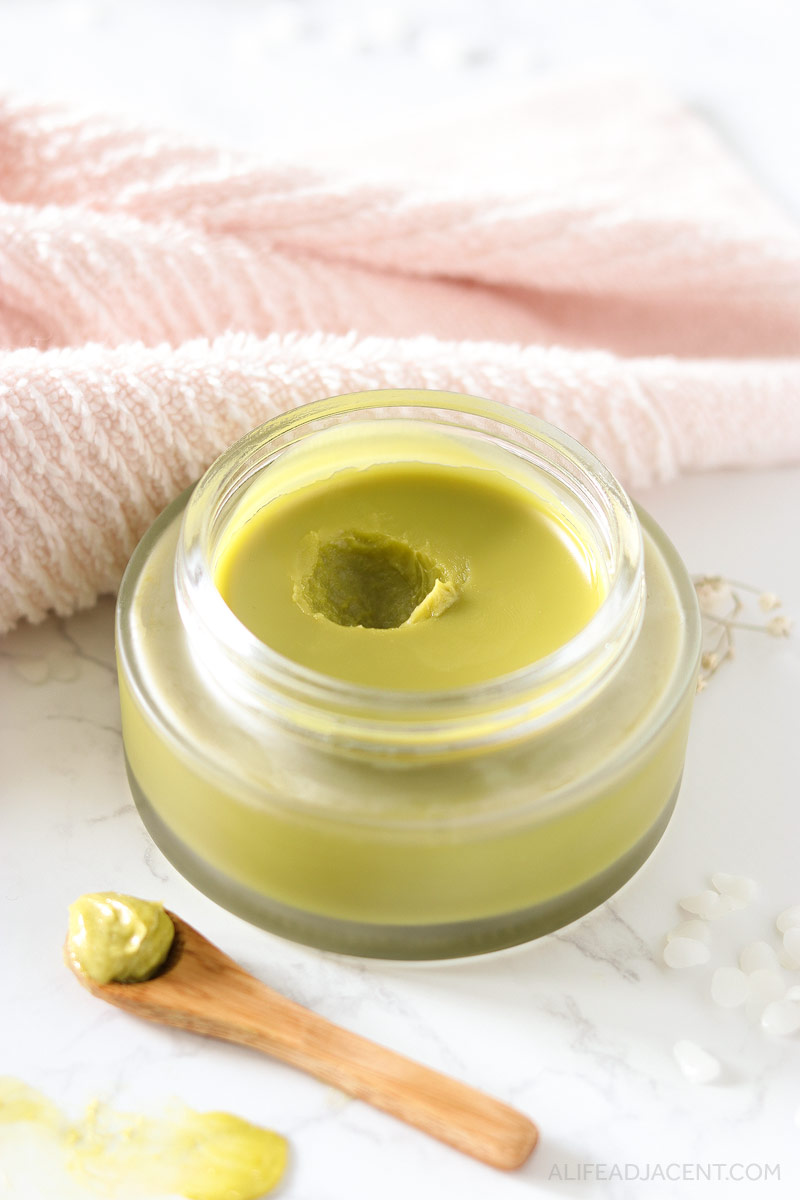
I don’t recommend substituting the squalane oil in this mask for any other oil. Squalane oil’s unique texture allows it to be used in high quantities without feeling heavy. Therefore, replacing it with anything else will completely alter the texture of this recipe.
So, I highly recommend sourcing some squalane. It’s very inexpensive, especially if purchased in larger bulk bottles. Plus, any leftover can be used in a variety of homemade beauty recipes, so it definitely won’t go to waste.
But if you must substitute, the closest option is caprylic/capric triglycerides, otherwise known as MCT oil. However, just know that MCT oil will create a heavier, less silky texture than squalane.
Beeswax
Beeswax’s main purpose in this recipe is to thicken the mask to a balm-like texture. However, beeswax also has a multitude of skin benefits that make it more than just a thickener.
Dry air or contact with bedding can dry out our skin while we sleep, so our skin is particularly vulnerable during this time.
When used in skincare products, beeswax creates a protective barrier that helps prevent skin moisture loss. This makes it a wonderful ingredient to use in a nighttime face mask.
I used filtered white cosmetic beeswax in this recipe. The benefit of white beeswax is that many of its allergenic constituents have been filtered out, making it tolerable even to those with very sensitive skin.
It also imparts a creamier, smoother texture than regular beeswax.
However, you can still use regular beeswax for this recipe. And if you’re vegan or highly allergic to beeswax, you can also use candelilla wax as a plant-based substitute.
Please see the recipe card at the bottom of this post for information on how to substitute beeswax.
Vitamin E oil
Vitamin E is the most important lipophilic antioxidant in our bodies.
In fact, some evidence suggests that one of the functions of sebum is to deliver vitamin E to our skin’s surface. This is how integral vitamin E is for skin health.
Since vitamin E is produced in our sebum, oilier skin has naturally higher levels. So if you have oily skin, you’re in luck. But topical vitamin E can benefit everyone.
Among other benefits, vitamin E helps stabilize the fatty acids in our skin, protecting them from damage and oxidative stress. It also helps improve skin hydration levels.
I added vitamin E oil to this green tea overnight mask for its moisturizing and antioxidant effects. A little goes a long way, as vitamin E is effective even at low concentrations.
Is this mask a moisturizer?
This mask helps keep your skin moisturized throughout the night. But because it does not contain any water, it’s important to note that it’s not a true moisturizer. Its texture is more like a green tea balm than a cream.
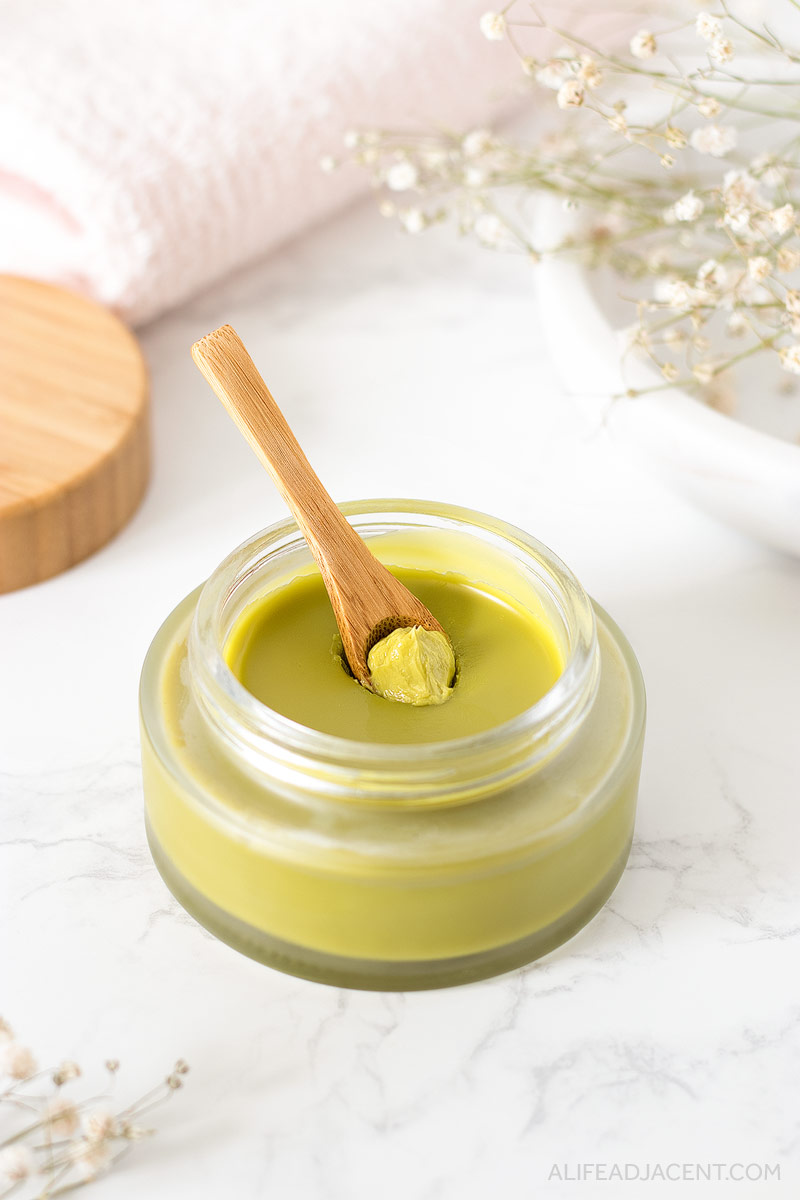
Oil-based products like balms and salves are occlusive. This means that they help your skin retain its existing moisture, but they don’t add any additional hydration to your skin.
In fact, occlusives applied to dry skin can actually make matters worse. They make it harder for water to leave your skin, but they don’t allow any water into your skin, either.
So, you should make sure your skin is sufficiently hydrated before using this overnight mask. That way, it can help lock the moisture from your other skincare products into your skin.
How to use this green tea overnight mask for glowing skin
Before using your mask, proceed with your nighttime skincare routine as usual, applying any hydrating serums, toners or moisturizers that you typically use before bed.
Some of my favourite products to use under this mask include Paula’s Choice BHA or SoonJung Moist Emulsion. You can also use a face mist for a bit of extra hydration. I like using grape water or my homemade rosewater face spray.
Once your skin is moisturized, scoop out a generous amount of the green tea mask and massage it gently into your skin.

Pay extra attention to the areas of your face prone to dryness, such as the cheeks. Don’t forget to pat some of the mask gently around the eyes too, as it makes a lovely eye treatment.
However, you should avoid any areas that are particularly oily or prone to breakouts, like the nose or forehead.
Depending on how much green tea wax you use, your mask could cause staining on clothing, bedding or pillowcases. So please use caution, especially with light coloured bedding.
How to store your mask
You should store your mask in a cool, dark place, as light degrades green tea wax. As well, it should be kept in a tightly sealed container such as a glass jar.
Since this recipe does not contain any water, it doesn’t need a preservative. It can be kept at room temperature for two years or more without going rancid, as squalane oil is highly stable.
As well, vitamin E helps slow down any oxidation in the final product.
But keep in mind that green tea wax’s shelf life is about a year, after which point its antioxidants and other constituents will begin to disintegrate. So ideally, you’ll want to use the mask up before it loses its efficacy.
Packaging ideas and tips for gifting
There’s something about beautiful packaging that helps take your homemade creations to the next level. I wanted my DIY skincare products to have a fancier, more upscale look that makes them ideal for gift giving.
So after a lot of searching, I was so excited to finally find the perfect containers – these gorgeous frosted glass jars with real bamboo lids.
These beautiful jars are perfect for gifting to loved ones and come in a variety of sizes. They add an element of luxury that makes any handmade gift look and feel like an expensive store bought product.
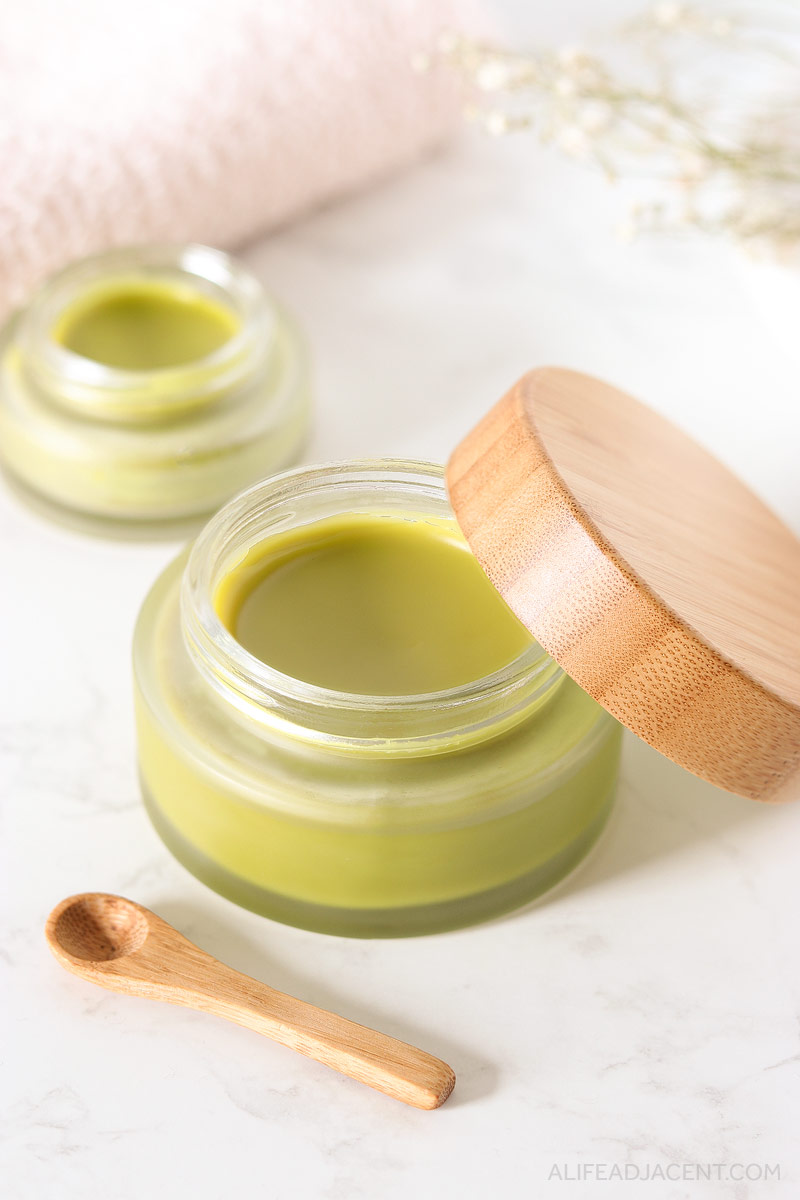
And if you simply love the way they look in your beauty cabinet, it’s fine to gift them to yourself, too! You can reuse them over and over again for future creations.
In fact, if you’ve spent any time on our blog, you have likely noticed that these are our favourite jars for displaying and photographing our DIY beauty products.
Since I made a larger batch, I used the 100ml jar for my overnight mask. But the jars also come in medium sizes for smaller batches, as well as a tiny 15ml variation that’s perfect for lip balm.
If you’re looking for more inexpensive ideas for packaging, small mason jars are always a great option. I also like these stainless steel condiment jars, which are both lightweight and durable.
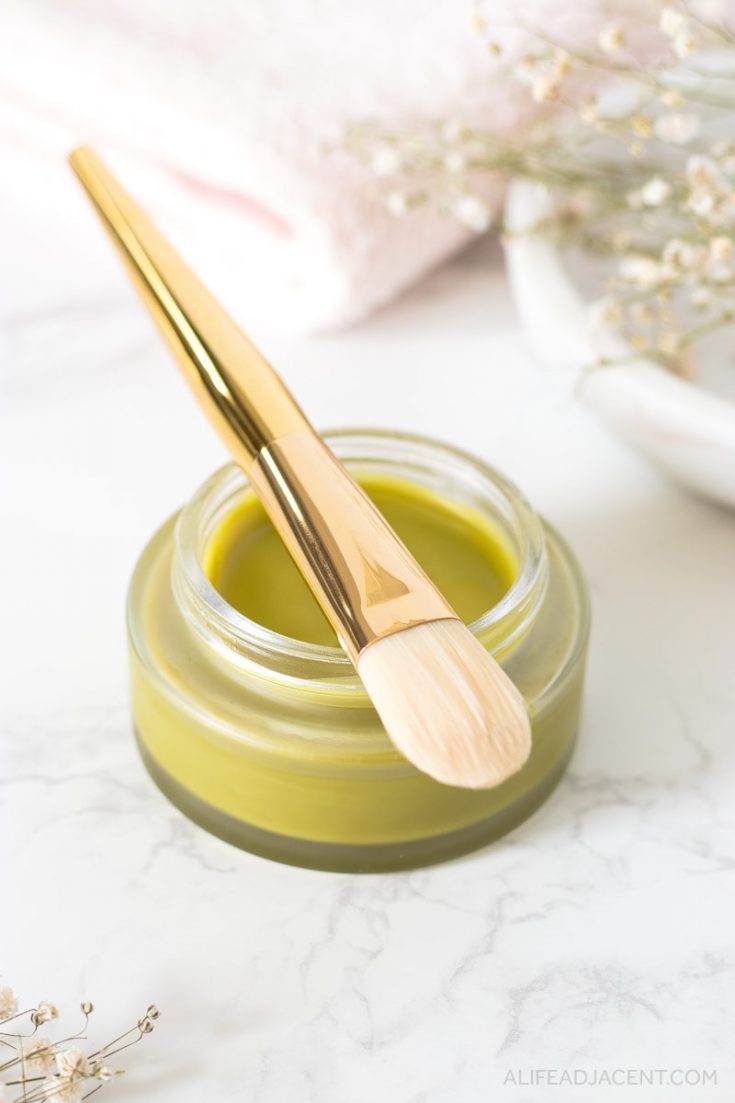
DIY Green Tea Overnight Face Mask for Glowing Skin
Wake up to glowing skin with this DIY green tea overnight face mask! Inspired by Korean skin care, this homemade recipe helps to brighten your skin while you get your beauty sleep.
Materials
- 2 tbsp squalane oil
- 1 tbsp white beeswax pellets
- 1/8 tsp vitamin E oil
- Small chunk of green tea wax OR 1 tsp matcha powder
Tools
- Turkish coffee pot
- Small spatula
- Glass cosmetic jar
Instructions
Overnight Face Mask with Green Tea Wax
- Using the double boiler method, combine squalane and beeswax over medium heat. (See recipe notes for tips.)
- Stir frequently to allow the beeswax to melt. Hold the mixture at medium heat for at least 5 minutes to ensure the beeswax is completely liquified.
- Once the beeswax has liquified, add the vitamin E and green tea wax and stir to combine. Remove from heat promptly once the green tea wax melts.
- Pour your overnight mask into your desired container, such as a small glass cosmetic jar or a condiment jar.
- Immediately place your mask into the refrigerator to harden for at least 30 minutes. This is important to ensure a smooth, pleasant texture that melts on contact with your skin. (See recipe notes.)
- Once the mask has hardened, remove it from the fridge. You can now store it at room temperature.
Overnight Face Mask with Matcha Powder
- Using the double boiler method, combine squalane, beeswax and matcha powder over medium heat. (See recipe notes for tips.)
- Stir frequently to allow the beeswax to melt. Hold the mixture at medium heat for at least 5 minutes to ensure the beeswax is completely liquified. This will also infuse the matcha powder into your mask.
- Once the beeswax has liquified, add the vitamin E and stir to combine. Remove from heat promptly.
- Pour your overnight mask into your desired container, such as a small glass cosmetic jar or a condiment jar.
- Immediately place your mask into the refrigerator to harden for at least 30 minutes. This is important to ensure a smooth, pleasant texture that melts on contact with your skin. (See recipe notes.)
- Once the mask has hardened, remove it from the fridge. You can now store it at room temperature.
Notes
- A small chunk of green tea wax is equal to about 1/16 of a teaspoon. However, this measurement does not need to be exact. You can add more green tea wax for extra antioxidant benefits, but you will end up with a darker coloured mask that is more likely to stain clothing and bedding.
- I like to use a small Turkish coffee pot over a water bath to melt small batches of product like this overnight mask. Its built-in lip makes it easy to transfer the mask into your desired container. Plus, its small size makes cleanup easy.
- Make sure that the beeswax has melted completely before continuing to the second step. If not, you could end up with a lumpy mask.
- Please be sure to place your mask into the refrigerator to harden. Leaving it at room temperature causes uneven cooling, which can make your final product lumpy or grainy.
- If using matcha powder, know that it will leave some sediment at the bottom of your mask. However, the rest of the product will be smooth and silky.
- To make a vegan version of this recipe, you can substitute beeswax for 1/2 tbsp candelilla wax.
Recommended Products
As an Amazon Associate and member of other affiliate programs, we earn from qualifying purchases.
More DIY skincare recipes for glowing skin
If you liked this mask, you might also enjoy these other homemade skincare recipes:
- DIY Overnight Sleeping Mask
- DIY Oil Cleanser with Green Tea
- DIY Aloe Vera Face Mask for Glowing Skin
- 2-Ingredient DIY Cleansing Oil
- DIY Caffeine Mask (Puffy Face Remedy)
- Makeup Melting DIY Cleansing Balm
For even more beauty and skincare, follow us on Pinterest! You can also find us on Instagram, Facebook, and Twitter.

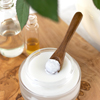

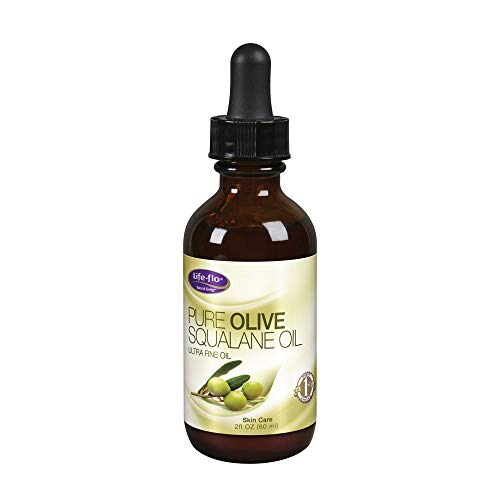
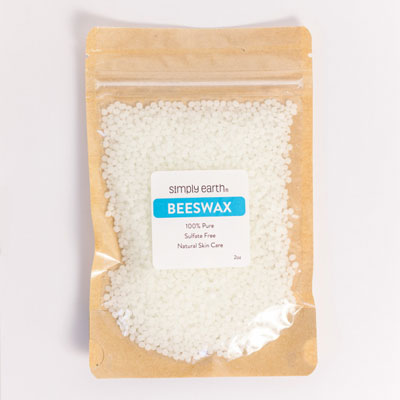



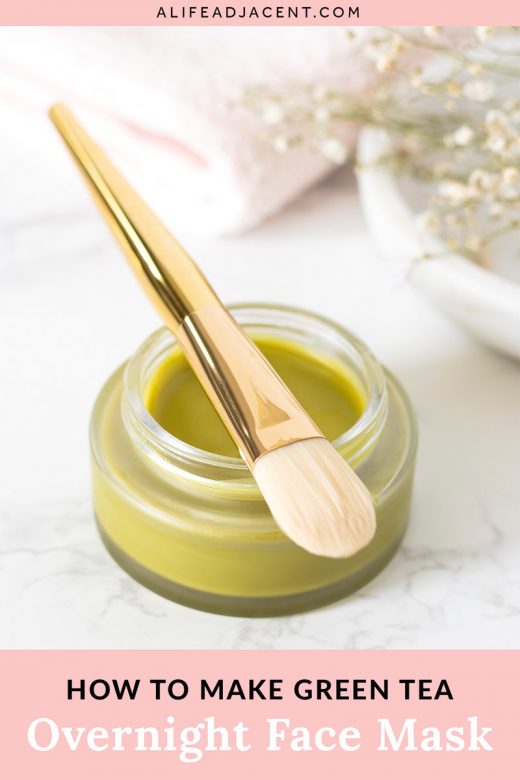
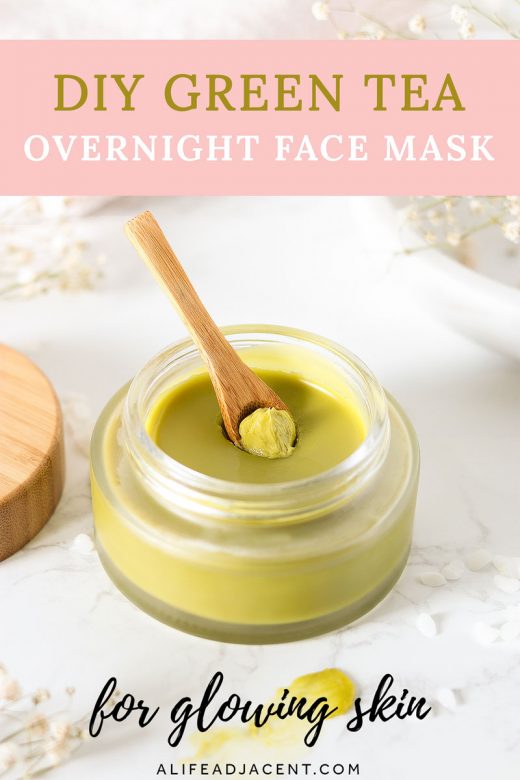
Emily T.
Tuesday 14th of February 2023
Hello ! I had a very bad experience with diy skincare before. They didn’t work for me, because my tools and bottles weren’t properly sterilized. How do you sterilize them ? Do you have any tips & tricks ? Thank you in advance !
P-S: I’ve have been advised to disinfect them in a dishwasher, but I don’t have any…
Kyla
Thursday 23rd of February 2023
Hi Emily, I'm sorry to hear you had a bad experience in the past! My preferred method is to wash with soap and hot water, then disinfect with high-proof alcohol.
If you don't have access to alcohol, you can also soak bottles and containers in hydrogen peroxide. But please make sure your equipment is peroxide safe, as peroxide corrodes metals. Alcohol is easier because you can use it on most things.
Another method is to wash your equipment with soap and water, then submerge it in boiling water to sanitize before allowing to dry completely. Of course, please be sure to take proper safety precautions and ensure your tools are heat-safe before using this method. I hope this helps!
Aysha
Tuesday 30th of August 2022
Thank you for this amazing mask, I tried it and it was amazing.. your instructions is perfect made me do it so easily. Thank you again.
Kyla
Thursday 1st of September 2022
I'm so happy to hear this Aysha! Thank you so much for sharing your experience and for leaving such a nice comment! 😊
Kamila
Tuesday 6th of April 2021
This recipe looks great! Can I use Vitamin E powder instead of oil? I have also green tea leaf extract powder, is this OK to use it in this recipe?
Kyla
Wednesday 7th of April 2021
Hi Kamila, I haven't tried green tea leaf extract, but I believe it should work. It just might leave a bit of a powdery sediment at the bottom of your mask.
As for the vitamin E powder, to be honest, I didn't know such a thing existed! I'm not sure about that. I would be concerned that it wouldn't dissolve in the mask, and might leave a grainy texture. So, I would stick with vitamin E oil, or just skip it if you don't have it on hand. 😊
Mojoblogs
Friday 19th of February 2021
Lately, I've been more into skincare than makeup. And I am so happy to have found this, I've been wanting to make a face mask at home so this is really going to be helpful. I also love that this is very informative, you even shared the benefits of this face mask on the skin. Thank you so much for this! More power to you! :)
Kyla
Saturday 20th of February 2021
Hi Mojo, I'm so happy to hear that! Thank you so much for your comment, and I hope you enjoy. 😊
Nicole
Thursday 21st of January 2021
Which essential oils/eo blends would pair well with this product?
Kyla
Thursday 21st of January 2021
Hi Nicole, I don't really recommend using essential oils in this recipe. They can be really irritating to the face as the skin is more delicate there. Personally, I don't use any essential oils on my face except for a small amount of blue tansy oil. It's the only one that doesn't seem to cause me problems. That is just my preference though. If you'd really like to use essential oils, I would ask a dermatologist or aromatherapist what they recommend. I hope this helps!